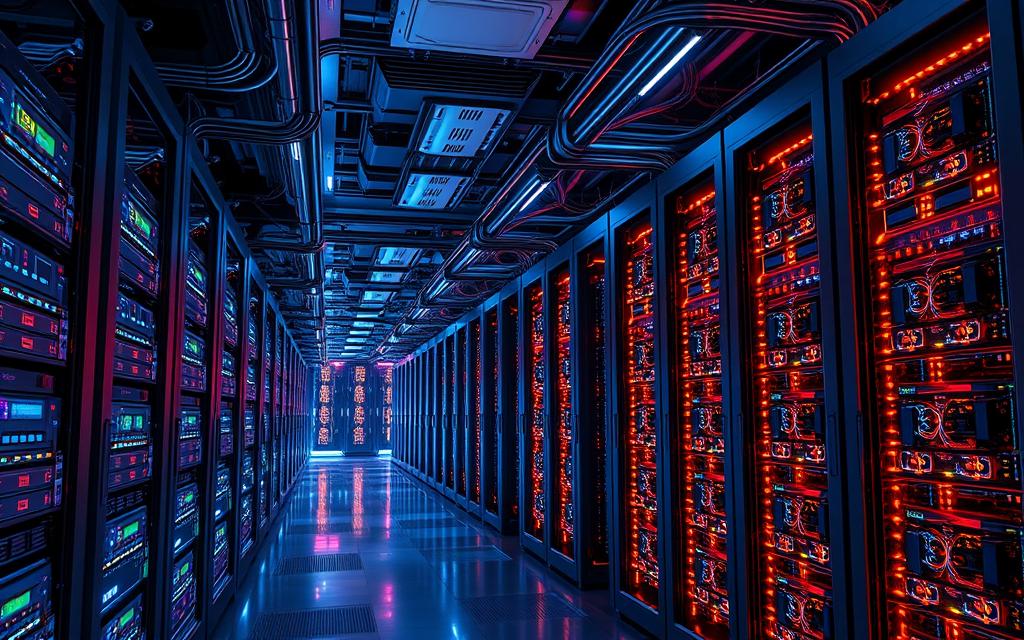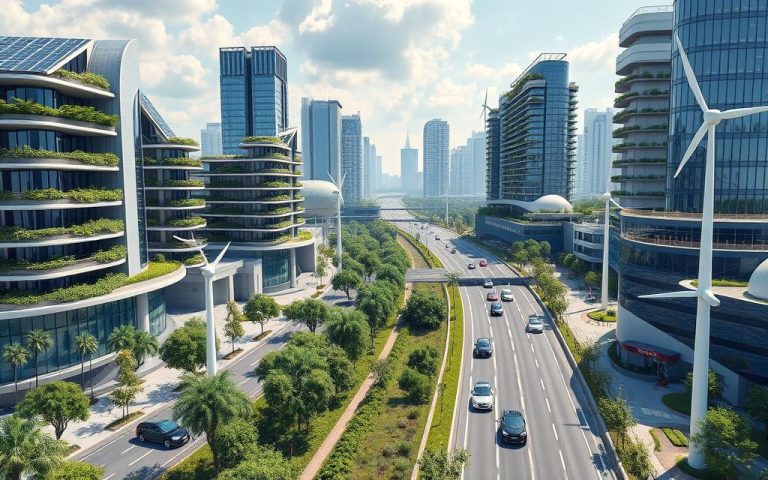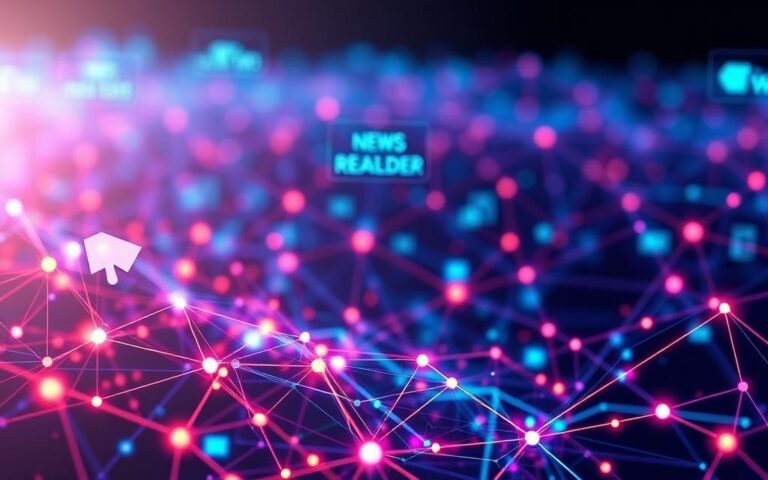Key Technologies Used in Data Centers
The digital age is making modern computing infrastructures more important than ever. Data center technologies are constantly changing, making them more efficient and sustainable. In 2019, companies spent more on cloud services than on traditional hardware for the first time. This shows how crucial key technologies are for managing data.
Yet, many businesses still prefer their own data centers. They worry about the openness and control of public cloud services, as 58% do. Using software-defined storage makes operations smoother and helps staff work better. Standards from groups like the Telecommunications Industry Association and the Uptime Institute help ensure data centers are reliable and fault-tolerant.
Advances in data centers include strong networks with top-notch security, like Check Point Maestro. This lets companies work safely. The image below shows what modern data center technologies look like.
Introduction to Data Center Technologies
The world of data centers has changed a lot. This change is driven by huge infrastructure demands and growing business needs. A deep dive into data centers shows a sector ready for more growth.
McKinsey & Company says the data center industry will grow by 10% every year until 2030. They also predict global investments in new data centers will reach USD 49 billion. This growth is because more businesses are going digital.
Google built the first hyperscale data center in The Dalles, Oregon. It’s huge, covering 1.3 million square feet. These centers can hold thousands of servers, with some as big as 60,000 square feet. IBM has over 60 data centers around the world, showing their big commitment to the market.
As the data economy grows, IDC says we’ll see a huge increase in data. They predict a tenfold rise in global data levels by 2025. This means we’ll have 175 zettabytes of data by then. This growth makes it even more important to have the latest technologies to meet these infrastructure demands.
It’s crucial for everyone to keep up with data center technology trends. This way, they can stay competitive and meet changing needs.
What Are Data Center Technologies
Data center technologies are systems and processes for managing data. They are key in today’s business world. Data centers support almost all computing and storage needs.
Definition and Importance
Data centers are the heart of digital infrastructure. They make data flow smoothly across platforms. They boost efficiency and performance for businesses.
Companies use cloud and colocation data centers. These offer flexibility and lower costs. They use models like infrastructure-as-a-service.
Evolution Over the Years
Data infrastructure has changed a lot lately. It moved from old systems to cloud solutions. Now, we see virtualized environments and hyperscale models.
Edge data centers are also new. They are close to users to improve app performance. They are great for tasks like big data analytics.
The trend of data centers evolving will keep going. By 2025, we’ll have over 180 zettabytes of data. Data center electric use could double by 2026.
This shows how important energy efficiency is. Data centers are getting better at meeting demands. They are also focusing on using new tech and being green.
| Data Center Type | Key Features | Typical Use Cases |
|---|---|---|
| Hyperscale | Large-scale, high-density, minimal cooling | Cloud providers, large enterprise applications |
| Cloud-Based | Infrastructure as a service, quick provisioning | Start-ups, scalable applications |
| Colocation | Rental space, managed by third parties | Businesses avoiding capital expenditure |
| Edge | Geographically close to users, low latency | Real-time data processing, AI applications |
Artificial Intelligence in Data Centres
The use of AI in data centres is changing how we manage them. It makes operations more efficient and productive. By using AI optimisation methods, companies can make their processes smoother and use resources better.
AI Optimisation Techniques
AI is now key in data centres for automating tasks and managing resources. McKinsey says 64-69% of data collection and processing time can be automated with AI. This cuts costs and lets people focus on important tasks.
The need for AI has grown, leading to more powerful data centres. These centres need servers with GPUs and TPUs for fast data processing. Traditional data centres use about 12kW per rack, while AI centres use over 60kW, showing a big change.
Impact on Cooling and Energy Efficiency
AI has a big effect on cooling efficiency and energy management. It helps monitor and adjust energy use in real-time, making things more sustainable. For example, using liquid cooling in high-power racks ensures cooling systems work well.
Power Usage Effectiveness (PUE) is a key measure of data centre energy use. It shows how important it is to use power and cooling wisely. AI helps data centres use energy better, making them sustainable and meeting business needs.
| Metric | Traditional Data Centres | AI Data Centres |
|---|---|---|
| Average Power Density | 12 kW per rack | 60+ kW per rack |
| AI Resource Requirement Increase | N/A | 10x |
| PUE (Optimal Efficiency) | <1.5 | <1.2 |
| Cooling Solution | Air Cooling | Liquid Cooling |
| Automation Potential | Limited | 64-69% Automatable |
Advancements in Cooling Technologies
The world of cooling technologies is changing fast. Old air cooling methods can’t keep up with new computers’ heat. New liquid cooling systems are more efficient, saving energy and boosting performance.
Liquid Cooling Solutions
Liquid cooling is a better choice than air cooling. It uses liquids to move heat away from parts. This method works well in many places and has big benefits.
- It cuts down facility power use by almost 20% compared to air cooling.
- Data centres use about 10% less total power.
- It also saves a lot of water, up to 90% in some cases.
Technologies like microchannel and direct-to-chip cooling are very good at moving heat. Microchannel cooling boosts performance by 20% to 40% and cuts air pressure drops. Direct-to-chip cooling needs much less airflow, up to 90% less, making cooling better.
AI-Driven Cooling Management
AI-driven cooling is the future of cooling data centres. It uses smart algorithms to watch and control temperatures in real time. This keeps data centres running smoothly and saves a lot of energy.
- It helps control temperatures better, reducing the chance of equipment problems.
- It makes cooling more efficient, even when workloads change a lot.
- It also makes cooling systems more flexible as technology gets better.
Using these new cooling technologies can change how data centres work. They can handle more work while being kinder to the planet. The money spent on data centres will go up to over $500 billion by 2027, showing how important these new cooling methods are.
| Cooling Technology | Energy Efficiency Gain | Water Usage Reduction |
|---|---|---|
| Liquid Cooling Systems | 20%-40% | Up to 90% |
| Two-Phase Immersion Cooling | 90%+ | Not Applicable |
| Microconvective Cooling | 8% | 90% |
| Calibrated Vector Cooling | Varies | Varies |
Networking Innovations for Enhanced Connectivity
Networking innovations have changed how data centres work, making them faster and more efficient. As data needs grow, using new technologies is key to staying ahead. The move to 5G is especially important for speeding up data transfer and making device communication smoother.
Role of 5G Networks in Data Centres
5G technology is changing data centre networks. Unlike old systems, 5G supports virtual and multicloud setups. It also uses new designs to cut down on delays and boost connections.
Switching to 5G means updating old systems, which can be tricky. But, it makes networks easier to manage and more efficient. For instance, Juniper’s Apstra software makes networks more flexible and quick to adapt.
New tech like Ethernet VPN and VXLAN overlays also helps networks work better. They use smart mapping to improve performance. With modern photonic systems, data centres can now move data at incredible speeds, like Ciena’s WaveLogicTM 5 at up to 800 Gb/s.
These advanced networks can grow to handle more data as needed. They use software-defined networking (SDN) to improve speeds and handle bigger data transfers. This makes the latest networking innovations real and useful.
| Technology | Benefits | Key Performance |
|---|---|---|
| 5G Technology | Enhanced data speeds, reduced latency | Up to 800 Gb/s per wavelength |
| Ethernet VPN (EVPN) | Improved network mapping and performance | Seamless integration across networks |
| Ciena’s WaveLogic™ 5 | Increased capacity and efficiency | Rates of 800 Gb/s on single wavelength |
| Juniper Apstra | Automated network operations | Reduced manual errors and tasks |
Data Center Automation and Remote Management
The world of data center automation is changing how we manage IT. It brings the power of remote management, making operations smooth and efficient. This means businesses can work better and faster, leading to more productivity and flexibility.
Benefits of Automated Processes
Automated data center processes bring many advantages. They make operations more effective. Key benefits include:
- Enhanced workflow: Automating tasks makes workflows smoother.
- Increased productivity: Staff can focus on important tasks, not just manual ones.
- Reduced errors: Automation cuts down on mistakes, reducing downtime and service issues.
- Optimised resource allocation: It saves costs by using resources wisely.
- Improved security: Automated systems enforce security rules, keeping data safe.
Impact on Workforce Efficiency
Data center automation changes how we work, making teams more efficient. With remote management tools, IT staff can manage from anywhere. This means they can:
- Address issues proactively: Automated alerts help staff solve problems early.
- Balance workloads: It helps distribute tasks better, using staff more effectively.
- Respond to incidents swiftly: Remote access speeds up fixing problems, making services more reliable.
In short, data center automation and remote management are key to making IT work better and faster.
Server Virtualisation for Enhanced Resource Utilisation
Server virtualisation has changed data centres a lot. It makes better use of resources and cuts costs. Now, one physical machine can run many virtual servers. This means big savings on hardware and better efficiency for companies.
Software-Defined Data Centres (SDDC)
Software-Defined Data Centres have taken server virtualisation to the next level. They make it possible to manage resources in a new way. This leads to better availability, disaster recovery, and security.
With SDDCs, businesses can use resources more efficiently. They can quickly adapt to changing needs. This makes them more flexible and responsive.
Scalability Advantages Through Virtualisation
Server virtualisation is great for growing or shrinking your IT setup. You can easily adjust to changes in workload. This means no need for big investments in new hardware.
It also makes managing backups and recovery easier. This keeps your business running smoothly, even when things go wrong.
In short, server virtualisation in Software-Defined Data Centres offers more than just cost savings. It brings better use of resources and flexibility to data centre management. Learn more about the benefits of data centre virtualisation.
Emerging Importance of Edge Computing
The world of data processing is evolving fast. This is thanks to the rise of Internet of Things (IoT) devices and new tech. Edge computing is at the heart of this change. It allows data to be processed close to where it’s created, making devices more efficient.
Many industries are now using edge computing for real-time data analysis. This technology is key to achieving great results.
Minimising Latency and Improving Performance
Edge computing is great at reducing latency. It makes devices respond faster by processing data locally. This is vital in areas like healthcare, smart cities, and self-driving cars.
For example, emergency services can act quicker thanks to edge computing. This leads to faster responses in urgent situations.
Edge computing also brings benefits to data centres. Companies see lower bandwidth costs, better service reliability, and faster data delivery. The introduction of 5G networks makes these advantages even stronger. It offers faster connections and supports more devices.
Organisations can use edge computing to boost their performance. This helps them stay ahead in a fast-changing market.
The future of edge computing looks bright. By 2025, more than half of enterprise data will be processed outside traditional cloud environments. This change shows the growing role of edge computing in data processing. Collaborative technologies fit well with this trend, helping teams work better and make smarter decisions.
The Rise of Hybrid Cloud Architectures
The move to hybrid cloud architectures is a big trend in today’s data centre architecture. It combines the best of public and private clouds. This helps companies improve security and keep flexibility in growing their systems. More than half of businesses plan to use hybrid clouds in the next year, up from 51% in 2018.
Hybrid clouds are great for keeping sensitive data safe. With over 87% of companies using multiple clouds, 72% are choosing hybrid. This mix of public and private clouds lets businesses use cloud computing solutions that fit their needs. It also helps in managing data better.
Kellogg’s is a good example of how well hybrid clouds work. They used AWS to improve their trade spending and handle huge amounts of data. Their data simulations got up to 90% faster, boosting their revenue.
Cloud spending is growing fast. It’s expected to hit over $1 trillion in 2024, with a 15.7% growth rate. This shows how important it is for companies to use hybrid clouds.

As cloud data grows to 100 zettabytes by 2025, hybrid solutions are key. They improve performance and meet the changing needs of businesses. For more on how tech helps with water efficiency, check out innovative solutions. The hybrid cloud path looks promising for companies to succeed.
Green Data Centres and Sustainability Initiatives
Data centres are now focusing on being more eco-friendly. They are moving towards green data centres. This means they are using less energy and more renewable sources.
These changes help the planet and make data centres more efficient. It’s a big step towards a greener future.
Renewable Energy Sources in Data Centres
Data centres are using solar, wind, and hydroelectric power. This reduces their need for fossil fuels. It makes their energy cleaner.
It’s known that data centres use about 3% of the world’s energy. Switching to renewables can greatly reduce their impact on the environment.
Reducing Carbon Footprints
Data centres are working on cutting their carbon footprint. They use tools like Power Usage Effectiveness (PUE) and Carbon Usage Effectiveness (CUE). These help them see how efficient they are.
By aiming for a lower PUE, they use energy better. Focusing on CUE helps them cut down on carbon emissions. This is good for the planet.
They also use new cooling systems and waste-heat recovery. This turns wasted energy into something useful. Green data centres use advanced systems to track energy use. This helps them find ways to use less.
Getting environmental certifications like LEED pushes them to do even better. It encourages them to keep improving their green efforts.
Conclusion
Data center technologies are changing fast, making them more efficient and green. New tech and better operations mean data centers can save money and work better. They also meet important rules.
Now, 58% of companies worry about cloud security. So, moving data to company centers is key. This move helps keep data safe and under control.
Data centers offer different uptime levels, from 99.671% to 99.995%. This shows why investing in strong data centers is smart. It helps deal with IoT’s latency and supports edge data centers for local needs.
It’s also important to watch for new tech trends. This helps companies stay ahead. By using new data center tech, companies can work better and be more green.
The future of data centers looks good. It promises a more connected, efficient, and green way to handle our data.
FAQ
What are the key technologies used in data centres?
Data centres use server virtualisation, AI optimisation, and advanced cooling solutions. They also use hybrid cloud architectures. These technologies make data centres more efficient, scalable, and sustainable.
How have data centre technologies evolved over the years?
Data centre technologies have changed a lot. They’ve moved from simple setups to complex, efficient systems. Now, they use cloud services, AI, and liquid cooling to meet growing demands.
What role does Artificial Intelligence play in data centre operations?
Artificial Intelligence helps data centres work better. It uses predictive analytics and improves cooling and energy management. For example, Google’s AI cooling system has saved a lot of money and helped the environment.
What are liquid cooling solutions and their benefits?
Liquid cooling is a better way to cool data centres than air. It uses fluids to keep temperatures down. This makes data centres more efficient, saves energy, and keeps them running smoothly.
How does 5G technology impact data centres?
5G makes data transfer faster and more reliable in data centres. It supports edge computing and requires more investment. But, it also brings better performance and justifies the costs.
What benefits does automation bring to data centres?
Automation makes data centres more efficient. It allows for better remote management and boosts workforce efficiency. Automation frees up staff to focus on important tasks, improving productivity.
What is server virtualisation and its significance?
Server virtualisation lets many workloads run on one server. It improves resource use and supports Software-Defined Data Centres (SDDC). This leads to better scalability and lower costs.
Why is edge computing becoming more important?
Edge computing reduces latency by processing data locally. It’s crucial for IoT devices and real-time data processing. Edge data centres help solve the challenges of fast data handling.
What are the advantages of hybrid cloud architectures?
Hybrid cloud combines public and private cloud benefits. It offers better security and control with scalable public infrastructure. It’s great for managing sensitive data and improving business strategies.
How are data centres addressing sustainability and carbon footprint reduction?
Data centres are using renewable energy like solar and wind. They focus on energy efficiency and sustainability. This helps reduce their carbon footprint and supports environmental goals.









